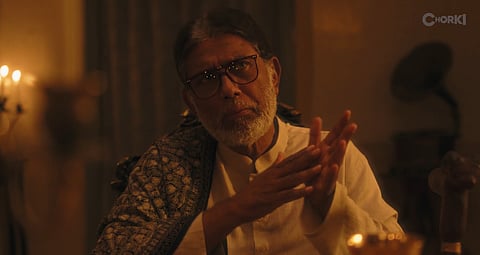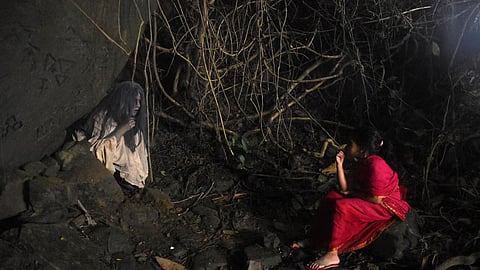With Moshari (2022) and Pett Kata Shaw (2022-present), Nuhash Humayun burst out full-fledged, as a singular, audaciously rooted voice in Bangladesh. In his playful grip, horror narratives tap not just his nation라이브 바카라 but a subcontinent라이브 바카라 roiling undercurrents—spiked with paranoia, divisive rhetoric, spirals of exclusionary violence. They are provocations, digging deep into rich cultural reservoirs and boldly reconfiguring them into the disturbed present-day zeitgeist.
Interview with Nuhash Humayun on Dui Shaw | “Horror a tool to explore South Asia라이브 바카라 darker side”
Bangladesh라이브 바카라 horror master discusses the ‘philosophical’ follow-up to the celebrated Pett Kata Shaw anthology
Few months after his latest project, the anthology Dui Shaw (2024-present), released on Chorki, it라이브 바카라 now headed to IFFLA (Indian Film Festival of Los Angeles) 2025. Ahead of the screening, Nuhash Humayun sat down with 바카라라이브 바카라 Debanjan Dhar for an exclusive chat, where he spoke about his vision of horror, navigating a troubled production, branching out from Bangladesh into global storytelling. Edited excerpts:
This is a more socially rooted anthology than Pett Kata Shaw. There라이브 바카라 a whole range of anxieties around capitalism, skewed social systems, modern-day greed, hierarchies, exclusionary violence. I was curious about your relationship to horror, specially how you view its role. Jordan Peele says horror is catharsis through entertainment—a way of working through one라이브 바카라 unaddressed pains. Have there been shifts in your understanding of the larger purpose of this genre?
Specially with Dui Shaw, horror was a tool to explore the dark side of South Asia, the darker issues we’re dealing with, not just in Bangladesh, but in the subcontinent. What are our fears? If you’re not doing horror sincerely, you’re not addressing your fears. When I’m starting a project, I ask myself: what am I afraid of? What truly terrifies me? Sometimes the answer is simple, like the dark or ghosts in the water, or something primal. However, sometimes it can also be deeper, philosophical. If I hear a sound in the middle of the night, what am I afraid of? Am I afraid of ghosts or people? I’m afraid of people, religious violence, what capitalism and power do to people, dynamics that happen in a home. If I’m not addressing these things, I’m not being sincere. I don’t think it라이브 바카라 exactly social responsibility. Horror is fun and entertaining. Our stories try to do that, while not forcing down messages. They are addressing at least some of what I am afraid of, what society itself is wary of.
Were you always sure that this time too, you wanted certain running threads throughout, characters walking through the stories, visual motifs like the masks, for example?
I was writing the stories at the same time and wondered what if I could link them. The masks came up then. It라이브 바카라 symbolic. What are the masks we wear, what happens when we take them off? Certain characters from the first season were so delicious and there was so much interest around them I toyed with bringing them back.

But you started with Mishti Kichu?
Definitely. That was about a man remembering everything, while Antara is the opposite. It라이브 바카라 almost a spinoff.
Tell me how it works with Chorki. Did you first toss a bunch of ideas and they suggested which ones seemed feasible or did you go back with these specific four and you worked from there?
With Chorki, they have been quite flexible. We got a slightly bigger budget this time, which is still small by international standards. In the middle of these two seasons, I did an episode for Hulu. But I just loved being home and filming something small and experimental. There라이브 바카라 an episode in Dui Shaw—a folk horror musical—which isn’t something I could do in Hollywood; or Waqt and the theme of religious violence, which could only work in a South Asia context. Chorki did notice some of the stories weren’t traditional jump-scare horror but more psychological. But they were super-flexible and trusting. They encouraged me to push boundaries. Their notes didn’t feel like feedback, rather conversation.

Some of the anthology was also shot during the July uprising in Bangladesh. There were also floods. How did you steer a production through such times?
There were natural disasters getting in the way of the production, but the biggest thing was the political revolution in Bangladesh. I was fully in support of the students but also wondered how to finish the shoot.
Had you shot some stuff already?
We had started already, yes. Suddenly, one day, we started hearing stories of people being shot. What was strange was we were filming the second story, Bhaggyo Bhalo during the uprising, which was about capitalism and power. Literally, it was about a man getting so much power that even death couldn’t stop him. It was surreal. What I was doing felt necessary. There are shots in that story of smoke coming out, which was actually from buildings set on fire as part of the uprising. It captures this important moment in Bangladesh라이브 바카라 history. I have mixed feelings about it. I’m both proud and cautious about it. I guess life imitates art and vice versa.
What was the most fun you had? Was it designing the deaths in the slasher?
Yes! (laughs) Things got so hectic that slasher was the most fun.
You shot in sequence?
Essentially, yes. We shot the second and third together. The final one took eight months because of the floods. There was a villager who was sick and they were dying. The villagers asked us if we could stop filming there, with one of them being severely ill. It was strange. We kept calling them week after week if the man was okay. Were we waiting for someone to die? Our lives almost turned into a bizarre horror series. The production feels like family. It라이브 바카라 a strange bonding. But it was all in the service of something necessary. If it was flimsy, I’d have just abandoned it. We need stories that represent and reflect the horrors of the world.

In Beshura, Jaya Ahsan라이브 바카라 character tells the girl, “Koshto theke shilpo hoye, shilpi holo koshter joy” (art springs from pain). Do you subscribe to this sentiment?
There are lots of dialogues in Beshura that I don’t subscribe to. One kept being quoted everywhere: if you don’t have art in you, you become a critic or teacher. I don’t really believe that. But I do understand Jaya라이브 바카라 line. Overcoming pain is a big part of art. The story explores why we create, who's gifted. Does creating bring us closer to something spiritual and holy?
Last time we spoke, you’d just signed a couple of representation deals. It라이브 바카라 been a while, and now you’ve joined the Writers Guild. Has it gotten at all easier, more accessible in any way—be it pitching to executives, getting a foot in the door, opportunities opening up in the West, without redesigning your stories?
That라이브 바카라 a really good question. It라이브 바카라 still really hard to get things made, no matter where you are in the world, or the traction that some of my work has got in international circuits and film festivals. I’m doing more projects in the Hollywood side because of agents I’ve signed with. They take care of my worries as to who’ll read whenever I’ve got a new script. They make sure it goes to the best producers. But again, no external producer can lift you if you aren’t putting out great work. The industries are very different. In the West, budgets are bigger, hence things are much slower. In Bangladesh, I work with infinitely smaller budgets but things are faster, more controlled. I like the idea of being a part of both the worlds. Filmmakers like Bong Joon Ho are big inspirations—who traverse both worlds, making something like Parasite (2019) in Korea as well as Mickey 17 (2025).
But do you feel it라이브 바카라 more effective to be based in the West to get work more actively?
That used to be the primary thinking earlier. It라이브 바카라 changed. Most producers prefer meeting on Zoom anyway. Also, a lot of the time, I’m just writing a script. But sometimes, it라이브 바카라 important to show up. Maybe, like two weeks in a year or a couple of months in LA, you do some meetings, say ‘Hi’ in person. Once you pitch/sell your script, you can go back to anywhere in the world and finish it. I didn’t have much of a guiding principle when I was starting out on this journey but I hope more people are encouraged to make big leaps.
Dui Shaw just started its journey in the West and played at SXSW. What was the response like?
Yes. It라이브 바카라 now coming to IFFLA. The response has been great. I’ve noticed there라이브 바카라 a great appetite for South Asian stories, especially our horror. People like to be transported to a different world. I love watching Dui Shaw at theatres and public screenings.
Do you stay through the screenings?
Yes! I’m not really watching the movie; rather, how the audience reacts. Watching horror with a group of people is the most fun thing.
Is there anything you can reveal about what라이브 바카라 the next thing you’re working on?
I’m working on a feature version of Moshari. That라이브 바카라 with a studio and has some cool producers. I’ve a few new scripts. Some of them are set in Bangladesh, others in different parts of the world. That라이브 바카라 a challenge I want to take. Can I tell a story that라이브 바카라 not necessarily linked to my identity? Sometimes, we’re put in boxes. If you’re South Asian, you’re expected to tell a particular kind of story. So I’m trying to play with that.
Dui Shaw screened at the Indian Film Festival of Los Angeles 2025.


